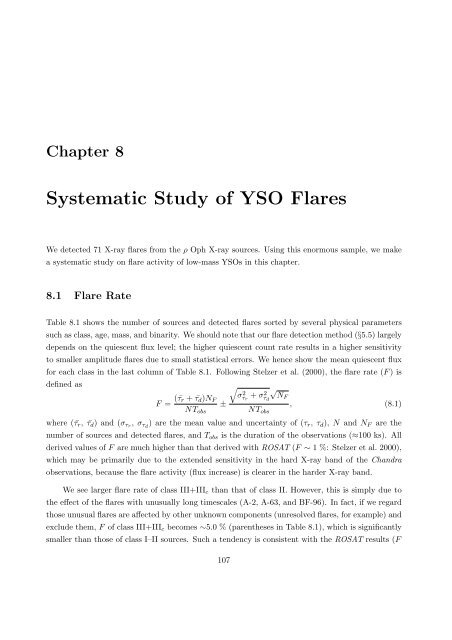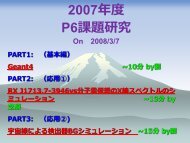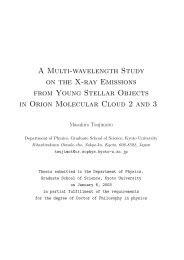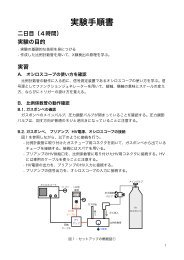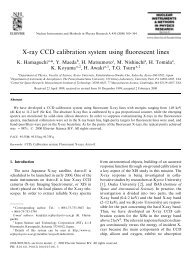X-ray Study of Low-mass Young Stellar Objects in the ρ Ophiuchi ...
X-ray Study of Low-mass Young Stellar Objects in the ρ Ophiuchi ...
X-ray Study of Low-mass Young Stellar Objects in the ρ Ophiuchi ...
Create successful ePaper yourself
Turn your PDF publications into a flip-book with our unique Google optimized e-Paper software.
Chapter 8Systematic <strong>Study</strong> <strong>of</strong> YSO FlaresWe detected 71 X-<strong>ray</strong> flares from <strong>the</strong> <strong>ρ</strong> Oph X-<strong>ray</strong> sources. Us<strong>in</strong>g this enormous sample, we makea systematic study on flare activity <strong>of</strong> low-<strong>mass</strong> YSOs <strong>in</strong> this chapter.8.1 Flare RateTable 8.1 shows <strong>the</strong> number <strong>of</strong> sources and detected flares sorted by several physical parameterssuch as class, age, <strong>mass</strong>, and b<strong>in</strong>arity. We should note that our flare detection method (§5.5) largelydepends on <strong>the</strong> quiescent flux level; <strong>the</strong> higher quiescent count rate results <strong>in</strong> a higher sensitivityto smaller amplitude flares due to small statistical errors. We hence show <strong>the</strong> mean quiescent fluxfor each class <strong>in</strong> <strong>the</strong> last column <strong>of</strong> Table 8.1. Follow<strong>in</strong>g Stelzer et al. (2000), <strong>the</strong> flare rate (F ) isdef<strong>in</strong>ed asF = ( ¯τ r + ¯τ d )N FNT obs±√σ 2 τ r+ σ 2 τ d√NFNT obs, (8.1)where ( ¯τ r , ¯τ d ) and (σ τr , σ τd ) are <strong>the</strong> mean value and uncerta<strong>in</strong>ty <strong>of</strong> (τ r , τ d ), N and N F are <strong>the</strong>number <strong>of</strong> sources and detected flares, and T obs is <strong>the</strong> duration <strong>of</strong> <strong>the</strong> observations (≈100 ks). Allderived values <strong>of</strong> F are much higher than that derived with ROSAT (F ∼ 1 %: Stelzer et al. 2000),which may be primarily due to <strong>the</strong> extended sensitivity <strong>in</strong> <strong>the</strong> hard X-<strong>ray</strong> band <strong>of</strong> <strong>the</strong> Chandraobservations, because <strong>the</strong> flare activity (flux <strong>in</strong>crease) is clearer <strong>in</strong> <strong>the</strong> harder X-<strong>ray</strong> band.We see larger flare rate <strong>of</strong> class III+III c than that <strong>of</strong> class II. However, this is simply due to<strong>the</strong> effect <strong>of</strong> <strong>the</strong> flares with unusually long timescales (A-2, A-63, and BF-96). In fact, if we regardthose unusual flares are affected by o<strong>the</strong>r unknown components (unresolved flares, for example) andexclude <strong>the</strong>m, F <strong>of</strong> class III+III c becomes ∼5.0 % (paren<strong>the</strong>ses <strong>in</strong> Table 8.1), which is significantlysmaller than those <strong>of</strong> class I–II sources. Such a tendency is consistent with <strong>the</strong> ROSAT results (F107


